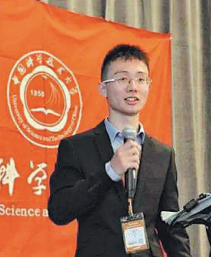On Dec 4, Science magazine announced a major breakthrough made by a team from the University of Science and Technology of China, led by its executive vice-president Pan Jianwei. It established China's leading position in the sphere of quantum computing research.
In November, the peer-reviewed Journal of Differential Geometry published a paper, authored by USTC professors Chen Xiuxiong and Wang Bin. Entitled Space of Ricci Flows II-Part B: Weak Compactness of the Flows, it marks a major breakthrough by proving two unresolved core conjectures-Hamilton-Tian conjecture and Partial C0-conjecture-in world mathematical circles for the first time in more than two decades.
In May this year, Cao Yuan, a USTC alumnus, recaptured people's attention by publishing two papers in the same issue of Nature magazine. It followed a "tsunami" he sparked two years ago when he released two theses on graphene in Nature. In 2018, Cao, dubbed a "graphene wrangler", ranked first among "Nature's 10", or "10 people who mattered this year."
At 14, Cao joined USTC's Special Class for the Gifted Young. It was a test ground in the reforms of Chinese higher education and a microcosm of the university's deep reform and innovation since 1970. During the period, USTC nurtured a large number of outstanding scientists, including Hou Jianguo, Pan Jianwei, Wu Weiren, Zhang Yaqin, Du Jiangfeng, Zhuang Xiaowei and Liu Qingfeng.
USTC's outstanding achievements are linked to its attraction of great talent. In 1970, when it was relocated to Hefei, there were only two members in the Academic Divisions of the Chinese Academy of Sciences and nine professors. Currently, there are 63 academicians of CAS and the Chinese Academy of Engineering, and 693 full professors.
USTC's remarkable achievements are due to its strength in discipline research and education. During the past 50 years, it became a national key university for major construction and was admitted to national projects of"211" and"985".
Ever since its establishment in 1958, USTC has set out to make important achievements in talent cultivation and scientific and technological innovation.
The university has prioritized talent cultivation and breakthroughs in innovation as its top two core tasks, aiming to take new steps in building a top-flight international university.
Currently, USTC has a broad range of academic disciplines covering natural sciences, engineering, management and some emerging interdisciplinary fields.
Located on the West Campus of USTC, the National Synchrotron Radiation Laboratory is the country's first national laboratory in China and owns the first dedicated synchrotron radiation facility in China-Hefei Light Source.
Ever since it was discovered, synchrotron radiation has been dubbed a "magical light."
The progress of human civilization can be measured in the utilization and development of "light resources."
As light is an electromagnetic wave, its different wavelengths can produce different light. The shorter the wavelength, the higher the energy. When people want to see a matter's structure at its smallest and clearest, especially an internal structure, they need to possess a shorter wavelength.
In order to observe more clearly, scientists explored for shorter and more energetic electromagnetic waves. At the end of the 1960s, the scientific world made a new discovery: synchrotron radiation.
Comparing an X-ray machine in a hospital with synchrotron radiation, the latter can be said of a super X-ray, tens of billions of times brighter than the former. This brightness can help people observe the atomic and molecular structure of matter. Such "magic light" has propelled countries the world over, especially developed countries, to set up their own synchrotron radiation experimental centers to build light sources. China was not left behind. In the early hours of April 29, 1989, China's first "magic light" burst forth from Hefei, illuminating a path for Chinese scientists.
In February 1978, the Chinese Academy of Sciences approved the research and physical design of a synchrotron radiation accelerator, with the project located in USTC in Hefei. The construction of HLS-I included phase-I project (1984-91) and phase-II project (1999-2004), winning the first prize of the National Science and Technology Progress Award in 1995.
HLS has been operating smoothly for nearly 30 years, with more than 18,000 domestic and foreign clients, seeing numerous important scientific achievements being made. Since 2006, NSRL has been targeting light sources in the low-energy realm of diffraction limit. From 2010, NSRL started HLS-II construction. With its completion, NSRL now owns a fully upgraded soft X-ray synchrotron radiation facility.
"We want to build the world's most advanced fourth-generation low-energy realm light source, in a bid to tackle the bottlenecks of industries," said Feng Donglai, NSRL director, as he announced the new mission of China's first dedicated synchrotron radiation facility-expanding HLS into Hefei Advanced Light Source.
"The fourth-generation light source can allow users to see the micro-cosmos much clearer," said Feng.

Cao Yuan, a USTC alumnus, shares details of his two papers published in Nature magazine. CHINA DAILY

The synchrotron radiation lab whirs with activity at the University of Science and Technology of China. CHINA DAILY
By YUAN SHENGGAO | CHINA DAILY | Updated: 2020-12-24 00:00
https://epaper.chinadaily.com.cn/a/202012/24/WS5fe3c5f9a31099a234352c06.html